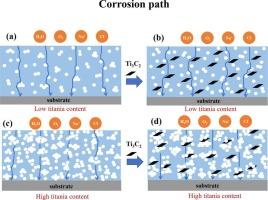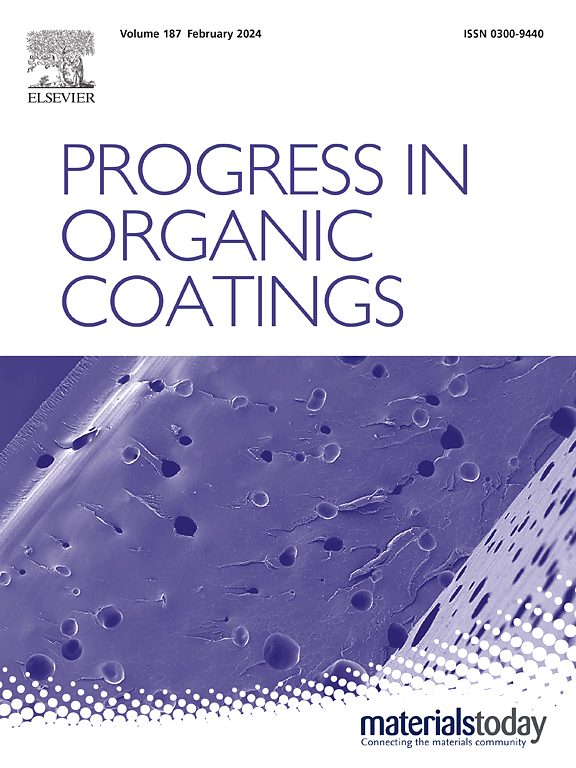The anticorrosion behavior and mechanism of Ti3C2 nanosheets for titania pigmented epoxy coatings
IF 6.5
2区 材料科学
Q1 CHEMISTRY, APPLIED
引用次数: 0
Abstract
Utilization of Ti3C2 nanosheets for enhancing anticorrosion of epoxy resin coatings has been reported. But the epoxy coatings in real world are mainly pigmented coatings. Unfortunately, the anticorrosion behavior of Ti3C2 nanosheets for the pigmented epoxy coatings is rarely concerned. In this work, both 0.5 wt% unmodified Ti3C2 nanosheets (U-Ti3C2) or 0.5 wt% (3-glycidyloxypropyl)trimethoxysilane-modified Ti3C2 nanosheets (G-Ti3C2) were introduced into solvent-based titania pigmented epoxy coatings. Corrosion resistance of coatings was evaluated by electrochemical impedance spectroscopy and salt spray tests. A titania concentration effect was interestingly exhibited for the anticorrosion behavior Ti3C2-containing pigmented coatings. Enhanced anticorrosion was only demonstrated when TiO2 content was not above 10 wt% for U-Ti3C2 or 5 wt% for G-Ti3C2. Moreover, the pigmented coatings with U-Ti3C2 have better corrosion resistance than those with G-Ti3C2, being contrary to the phenomenon observed in pure epoxy resin coatings. The different anticorrosion behavior of Ti3C2 nanosheets for epoxy coatings with various TiO2 contents was mainly attributed to the different dispersion states of TiO2 pigments, that is, improved dispersion at low TiO2 content and deteriorated dispersion at high TiO2 content, after addition of Ti3C2 nanosheets.

纳米 Ti3C2 片在二氧化钛颜料环氧涂料中的防腐行为及机理研究
利用 Ti3C2 纳米片增强环氧树脂涂料的防腐效果已有报道。但现实世界中的环氧树脂涂料主要是颜料涂料。遗憾的是,Ti3C2 纳米片在环氧树脂颜料涂层中的防腐性能很少受到关注。本研究将 0.5 wt% 未改性 Ti3C2 纳米片(U-Ti3C2)或 0.5 wt%(3-缩水甘油氧丙基)三甲氧基硅烷改性 Ti3C2 纳米片(G-Ti3C2)引入溶剂型二氧化钛颜料环氧涂料中。通过电化学阻抗谱和盐雾试验对涂层的耐腐蚀性进行了评估。在含 Ti3C2 的颜料涂层的防腐性能方面,有趣地显示出了二氧化钛浓度效应。只有当 U-Ti3C2 的二氧化钛含量不超过 10 wt% 或 G-Ti3C2 的二氧化钛含量不超过 5 wt% 时,防腐性能才会增强。此外,含有 U-Ti3C2 的颜料涂层比含有 G-Ti3C2 的涂层具有更好的耐腐蚀性,这与在纯环氧树脂涂层中观察到的现象相反。Ti3C2 纳米片在不同 TiO2 含量的环氧树脂涂料中具有不同的防腐性能,这主要归因于添加 Ti3C2 纳米片后 TiO2 颜料的分散状态不同,即 TiO2 含量低时分散性改善,而 TiO2 含量高时分散性变差。
本文章由计算机程序翻译,如有差异,请以英文原文为准。
求助全文
约1分钟内获得全文
求助全文
来源期刊

Progress in Organic Coatings
工程技术-材料科学:膜
CiteScore
11.40
自引率
15.20%
发文量
577
审稿时长
48 days
期刊介绍:
The aim of this international journal is to analyse and publicise the progress and current state of knowledge in the field of organic coatings and related materials. The Editors and the Editorial Board members will solicit both review and research papers from academic and industrial scientists who are actively engaged in research and development or, in the case of review papers, have extensive experience in the subject to be reviewed. Unsolicited manuscripts will be accepted if they meet the journal''s requirements. The journal publishes papers dealing with such subjects as:
• Chemical, physical and technological properties of organic coatings and related materials
• Problems and methods of preparation, manufacture and application of these materials
• Performance, testing and analysis.
文献相关原料
公司名称
产品信息
阿拉丁
xylene
阿拉丁
n-butyl alcohol
阿拉丁
ethanol
 求助内容:
求助内容: 应助结果提醒方式:
应助结果提醒方式:


